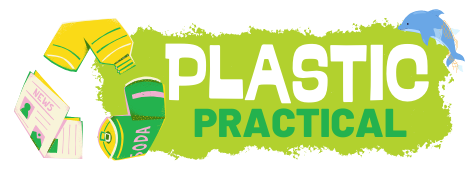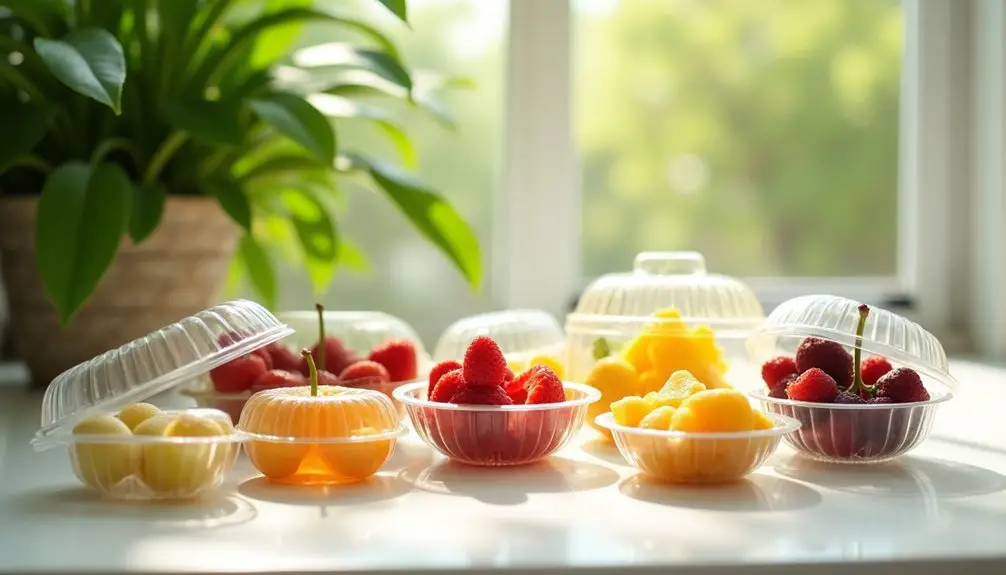Clamshell packaging is versatile and widely used in industries like food, retail, and electronics. You'll find types like transparent, blister, and food clamshells, each designed for specific applications. They protect products and enhance visibility, making them perfect for branding and marketing. However, sustainability is a concern, as recycling rates are low, and many materials aren't accepted by recycling facilities. Eco-friendly options are emerging, such as biodegradable and recycled materials. If you're curious about the latest trends in clamshell packaging and how they affect your choices, there's plenty more to explore on this topic.
Key Takeaways
- Clamshell packaging, invented in 1978, comes in types like transparent, blister, and food clamshells, suitable for various applications.
- Common materials include PET, PVC, and biodegradable options like sugarcane bagasse, enhancing food protection and environmental sustainability.
- Recycling challenges persist due to contamination and low acceptance rates, with only about 11% of Material Recovery Facilities processing clamshells.
- Eco-friendly alternatives and sustainable practices, such as the How2Recycle label, promote responsible disposal and reduce plastic waste.
- Transparent clamshells enhance product visibility, supporting branding and consumer trust, particularly in the growing e-commerce market.
Overview of Clamshell Packaging
Clamshell packaging is a versatile and widely used solution for protecting and displaying products. Invented by Thomas Jake Lunsford in 1978, this design features a pocket made from formable web materials, typically thermoformed plastic.
Initially crafted from polystyrene, polyester, and PVC, clamshells have evolved to incorporate recycled paper and plastic films, focusing on sustainability. Clamshells were historically popular due to their practical benefits for manufacturers.
You'll find various types of clamshell packaging, made from materials such as PET and PVC, with wall thicknesses ranging from .010" to .060". They can be transparent, allowing customers to see the products inside clearly.
Sealing methods vary, including self-locking tabs and heat sealing, catering to different needs and preferences.
Clamshells have multiple applications across industries. In the food sector, they package items from salads to BBQ ribs, while in retail, they're used for toys, electronics, and personal hygiene products.
They also provide secure transport during shipping and minimize theft and damage when displayed. As the demand for eco-friendly options grows, you can now find clamshells made from recyclable or biodegradable materials, making them a practical choice for environmentally conscious consumers.
Plastic Clamshell Packaging
When it comes to packaging solutions, plastic clamshell packaging stands out for its protective and versatile nature. You'll find this type of packaging widely used across various industries, especially in retail and food. Here are four key types you might encounter:
- Plastic Clamshell Packaging: The most common type, ideal for protecting products.
- Clear Clamshell Packaging: Perfect for retail items, showcasing the product inside.
- Food Clamshell Packaging: Made from food-grade plastic, ensuring safe storage and transport.
- Retail Clamshell Packaging: Designed to attract customers for products like toys and electronics.
While plastic clamshells offer benefits, they come with significant drawbacks. They're often difficult to open, can take up more storage space, and aren't suitable for liquids. Recycling can be complicated due to the different materials used, making sustainability efforts challenging. Moreover, the high volume of plastic contributes to environmental concerns, as most clamshells aren't recycled effectively. This is particularly important to consider, as clamshell packaging often leads to increased waste if not managed properly. Understanding these factors can help you make informed choices about packaging in your business or daily life. The low recycling rate of plastics, with only about 9% of all plastics being recycled, highlights the need for alternative and more sustainable packaging solutions.
Blister Clamshell Packaging
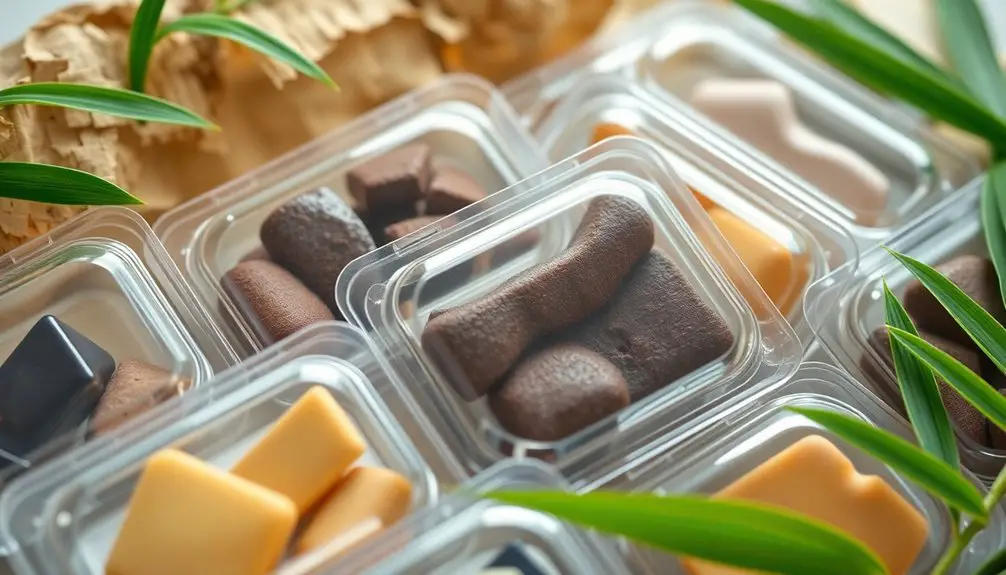
Over the years, blister clamshell packaging has gained popularity for its ability to protect products while providing clear visibility. This type of packaging typically features a hinged structure, allowing the two sections to fold over and securely attach. You'll often find materials like polystyrene, polyester, and PVC being used due to their durability and ease of molding.
Blister clamshells can be customized to fit various product shapes, making them versatile for different applications. The cavity size is tailored to the product's dimensions, ensuring a snug fit. Security is also a priority, with designs incorporating self-locking tabs or snap closures for easy yet secure sealing. Additionally, they offer high theft resistance compared to other packaging types, making them a secure choice for retailers.
In terms of applications, blister clamshells are widely used for packaging food items, electronics, pharmaceuticals, cosmetics, and small tools. Their transparent nature allows consumers to see the product clearly, enhancing the shopping experience.
Additionally, these clamshells can be produced using recycled materials, promoting sustainability. Overall, blister clamshell packaging combines functionality with aesthetic appeal, making it a popular choice for both manufacturers and consumers alike.
Clear Clamshell Packaging
Clear clamshell packaging offers you the perfect blend of visibility and protection for your products. Its design versatility allows for various shapes and sizes, catering to your specific needs. However, you'll also need to consider the recycling challenges that come with different materials used in these packages. Notably, clamshell containers made from PET plastic are 100% recyclable, making them a more environmentally friendly choice. To ensure proper disposal, look for the How2Recycle label to confirm if your packaging is eligible for recycling at local drop-off points.
Visibility and Protection
Clamshell packaging offers a perfect blend of visibility and protection, making it a popular choice for retailers and consumers alike. The transparent material allows you to see the product inside, enhancing its appeal. This visibility is crucial for making informed purchasing decisions and helps build trust in the brand.
Key features that contribute to both visibility and protection include:
- Transparent Material: Clear plastic lets customers view contents without opening the package.
- Durable Construction: Rigid plastic protects items from physical damage during shipping.
- Moisture Protection: Keeps products dry, ensuring they remain in good condition.
- Tamper-Evident Design: Heat sealing and locking mechanisms prevent tampering, ensuring integrity.
These features not only showcase the product effectively but also guard against dust and moisture.
Additionally, the reclosable design allows you to secure the product after use, maintaining its quality. Furthermore, clamshell packaging is made from food-grade safe plastic, ensuring safety for food items.
With this combination of visibility and protection, clamshell packaging stands out as a reliable choice for various industries, from retail to food, ensuring your products remain safe and appealing.
Design Versatility
With its combination of visibility and protection, the design versatility of clamshell packaging makes it an appealing choice for a wide range of products. You can customize clear clamshells in various shapes and sizes to snugly encase your products, ensuring they remain secure during transportation and display. The transparent design allows customers to see the product inside, enhancing appeal and creating trust. Additionally, clamshell packaging provides protection during transportation, ensuring that items arrive at their destination in excellent condition.
You'll find that clamshell packaging offers excellent branding opportunities, as you can print logos and product information directly on the packaging. This not only boosts brand visibility but also informs consumers about what they're purchasing.
You also have material options, from traditional plastics to eco-friendly alternatives made from recycled content or bio-based materials.
User-friendly features add to the versatility; the secure closure methods like perimeter and button snaps keep the packaging intact while remaining easy to open. Plus, clamshells can be designed for reusability, making them convenient for consumers.
Recycling Challenges
Recycling clamshell packaging presents several significant challenges that hinder its effectiveness in sustainability efforts. When you try to recycle these clear clamshells, you face a few key hurdles:
- Label Adhesives and Contamination: Strong adhesives on labels can contaminate the recycling stream, complicating the sorting and processing of clamshells.
- Material Properties and Processing: Clamshells have different bulk densities and intrinsic viscosities compared to PET bottles, making them harder to process effectively. This variation in material properties can lead to significant difficulties in recycling clamshells alongside traditional PET containers.
- Acceptance Rates and Infrastructure: Only about 11% of Material Recovery Facilities (MRFs) accept plastic clamshells for recycling, revealing a significant gap in infrastructure.
- Economic and Regulatory Factors: The current economic landscape makes recycling clamshells less viable due to contamination costs and a lack of regulatory support.
These challenges contribute to the inefficiency of recycling processes and often lead to lower market values for recyclable materials.
As you navigate these issues, understanding the intricacies of clamshell recycling is crucial for improving sustainability efforts in your community.
Food Clamshell Packaging
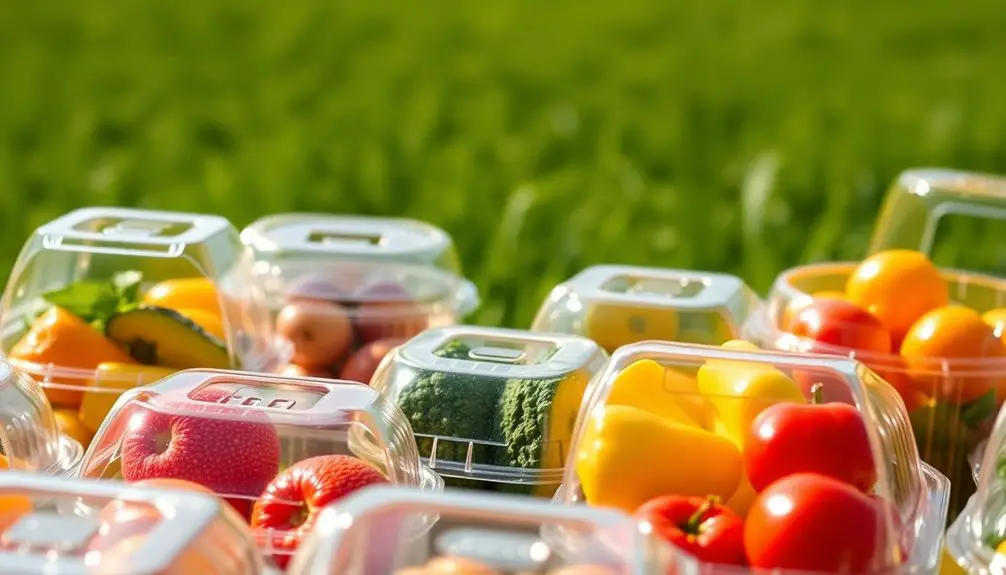
Choosing the right packaging for food can significantly impact both product appeal and customer satisfaction.
Food clamshell packaging comes in various types, each with its own benefits. Plastic clamshells, made from PET and PVC, are the most common. If you prefer something more sustainable, consider paperboard clamshells for hot foods or plant fiber clamshells made from wheat grain, which are soak-proof and suitable for both hot and cold items.
You'll find that these clamshells offer excellent food protection, ensuring your products remain intact during storage and transport. Their transparency allows customers to see the contents, enhancing product appeal and the shopping experience.
Versatile and convenient, clamshells can hold everything from sandwiches and salads to desserts and chicken wings, making them ideal for supermarkets, food trucks, and catering businesses.
However, while these packaging options are functional, sustainability concerns are growing. High plastic volumes and recyclability issues are problematic for many consumers.
Opting for eco-friendly alternatives like paperboard or plant fiber clamshells can help reduce environmental impact. Being mindful of your packaging choice not only boosts your brand but also aligns with a more sustainable future. Additionally, considering the carbon footprint of packaging materials is crucial in making informed decisions about the environmental effects of packaging choices.
Retail Clamshell Packaging
Retail clamshell packaging serves as a versatile and effective solution for displaying a wide range of products, from electronics to personal care items. This type of packaging not only enhances product visibility but also provides essential protection during shipping and handling.
Here are some common types of retail clamshell packaging you might encounter:
- Plastic Clamshell Packaging: Commonly used and available in various sizes and shapes.
- Clear Clamshell Packaging: Made of clear plastic, allowing maximum visibility of the product.
- Blister Clamshell Packaging: Ideal for electronics, featuring a clear front and a paper or plastic back.
- Custom Clamshell Packaging: Tailored to fit specific product dimensions and branding needs.
When choosing retail clamshell packaging, consider its benefits like protection, visibility, and customization. It can enhance brand recognition through logo placement and offers convenience with easy access for consumers.
However, keep in mind the challenges, such as recyclability and design complexity, which could impact your decision. Overall, retail clamshell packaging is a practical choice that helps your products stand out in a competitive market.
Many clamshell packaging types are made from plastic materials that have specific recycling codes, which is crucial for consumers to understand in order to properly recycle them.
Eco-Friendly Clamshell Packaging
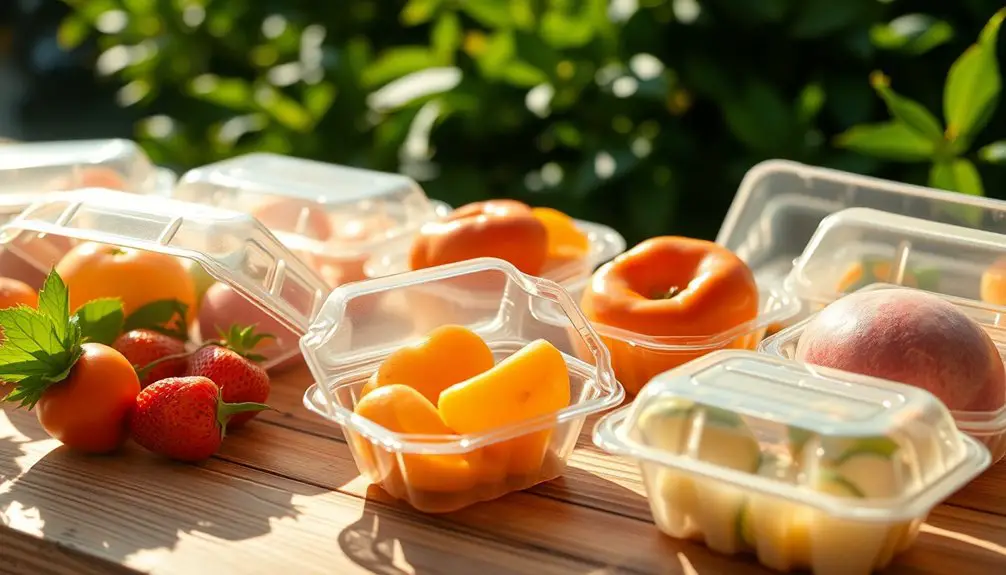
Eco-friendly clamshell packaging is gaining traction as a sustainable alternative to traditional plastic options, appealing to environmentally conscious consumers and businesses alike. These containers are made from materials like sugarcane bagasse, cornstarch, and plant fibers, which are 100% biodegradable, compostable, and recyclable. By choosing eco-friendly clamshells, you contribute to reducing plastic waste and lowering your carbon footprint. Using beeswax wraps as an alternative to plastic wrap for food storage can also significantly reduce plastic waste and promote a more sustainable lifestyle.
| Material | Benefits |
|---|---|
| Sugarcane Bagasse | 100% biodegradable, compostable, toxin-free |
| Cornstarch | Fully biodegradable, renewable source |
| Plant Fiber | Compostable, made from renewable resources |
| PLA | Biodegradable, made from U.S. grown corn |
| Paperboard | Recyclable, made from renewable wood fibers |
These eco-friendly options are not just sustainable; they also provide durability, moisture resistance, and customization. They're safe for both microwave and freezer use, ensuring versatility in storage. By opting for these clamshells, you're making a conscious choice for a healthier planet.
Clamshell Packaging in Food Industry
Clamshell packaging plays a crucial role in the food industry, offering an effective solution for preserving the freshness and quality of a wide range of food items.
You'll find clamshells used for various applications, ensuring products remain secure during transport and storage. Here are some common uses:
- Sandwiches: These are packaged to keep them fresh and intact.
- Pies: Both sweet and savory pies benefit from clamshells for retail and catering.
- Cookies: Baked or frozen, cookies stay fresh in clamshells.
- Bread: Freshly baked bread, including artisanal types, is often packaged this way.
In retail settings, clamshells are prevalent in markets, food stands, food trucks, and catering services, even extending to online retailers.
They comply with FSMA regulations, ensuring food safety through hazard analysis and preventive controls.
Material considerations also play a role; while plastic is common, alternatives like cardboard and recycled paper enhance sustainability.
With features like tamper-evident seals, clamshells guarantee product integrity and consumer safety, making them a staple in the food industry.
Clamshell Packaging in Retail Industry
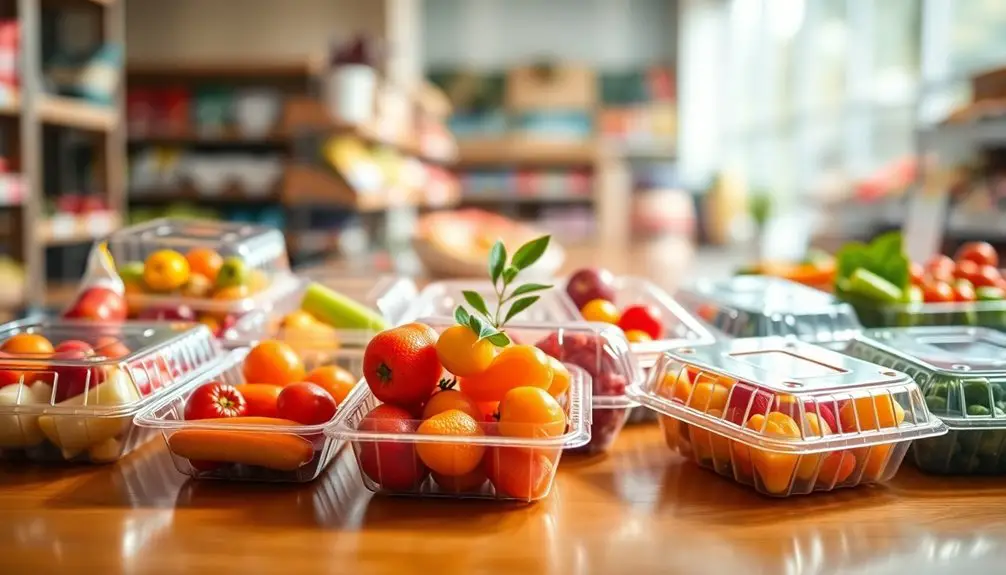
In today's fast-paced shopping environment, packaging plays a pivotal role in attracting customers and influencing their purchase choices. Clamshell packaging stands out in the retail industry for its versatility and effectiveness. Clear clamshell packaging elevates product visibility, letting you see the item without opening it.
If you need something more tailored, customizable options fit specific sizes and shapes, enhancing both protection and presentation. You'll find clamshells in various retail sectors, from electronics to cosmetics and toys. They provide a secure barrier against damage during shipping while keeping products on display.
Plus, branded clamshell packaging offers an opportunity to showcase your company's logo, boosting brand recognition. The convenience factor is another major advantage. These packages are easy to open, making it simple for you to access products quickly.
As the e-commerce landscape grows, demand for attractive, durable packaging continues to rise. With over 35% of the North American market share in 2023, clamshell packaging is clearly a popular choice among retailers. It's an effective way to meet consumer preferences, ensuring your products stand out on the shelves.
Sustainability Challenges and Solutions
When it comes to clamshell packaging, you'll find that recycling can be tricky due to the materials used and their design.
Fortunately, there are eco-friendly alternatives and sustainable design practices that can help reduce waste and improve recyclability.
Let's explore how these solutions can make a positive impact on the environment.
The implementation of recycling infrastructure can significantly enhance the recyclability of clamshell packaging and reduce plastic waste.
Recycling Difficulties Explained
Many people don't realize the recycling challenges posed by clamshell packaging, which often complicates waste management efforts. These challenges can lead to significant sustainability issues.
Here are four key difficulties you might encounter when trying to recycle clamshells:
- Label Adhesives: Strong adhesives on labels are tough to remove, making it hard to clean the clamshells properly.
- Material Differences: Clamshells use different intrinsic viscosities compared to other plastics, causing uneven melting during recycling.
- Contamination Issues: Clamshells can be confused with other plastics like PVC, leading to contamination in mixed recycling streams.
- Sorting Complexity: Manual sorters at Material Recovery Facilities (MRFs) often struggle to identify PET clamshells amid other plastics.
These factors contribute to the economic unviability of recycling clamshells, as facilities face increased costs when processing contaminated materials.
To tackle these recycling difficulties, it's essential to explore solutions like improved label design, advanced sorting technologies, and raising consumer awareness about proper disposal methods.
Eco-Friendly Material Alternatives
What if you could choose packaging that not only protects your products but also supports sustainability? You can opt for eco-friendly material alternatives that make a real difference.
Recyclable materials like PET and HDPE are accepted by most curbside recycling programs and can integrate recycled content, making them budget-friendly and sustainable.
Biodegradable and compostable plastics provide another option. While biodegradable plastics need specific landfill conditions, compostable items break down naturally when placed in a compost bin, lessening landfill waste. They also have an appealing aesthetic and maintain protective qualities.
Bioplastics, created from renewable sources like starch, reduce dependence on fossil fuels. Using plant-based options like PLA in your clamshell packaging aligns with eco-friendly production techniques, ensuring a lower environmental impact.
Finally, consider paper clamshells. They're biodegradable, compostable, and come in various shapes and sizes. This flexibility makes them suitable for delicate items or larger products, reflecting your commitment to environmental responsibility.
Sustainable Design Practices
Sustainable design practices in clamshell packaging focus on reducing environmental impact while ensuring product protection. By incorporating effective strategies, you can significantly contribute to sustainability in your packaging solutions. Here are some key practices to consider:
- Material Selection and Optimization:
- Use recyclable materials like PET or bioplastics to minimize waste.
- Avoid mixed materials to simplify the recycling process.
- Design for Recycling:
- Clearly label packaging to guide proper disposal.
- Design for disassembly, allowing easy reuse of components.
- Minimize Packaging:
- Reduce the size of clamshells to fit products perfectly.
- Implement minimalist designs that maintain protection without excess materials.
- Encourage Reuse and Recycling:
- Create reusable containers that consumers can repurpose.
- Educate consumers about the recyclability of your packaging.
Frequently Asked Questions
What Are the Cost Differences Between Clamshell Packaging Types?
When comparing costs, you'll notice plastic clamshells generally require higher tooling investments, while blister packaging is cheaper. Thermoform options can be pricier due to materials, and styrofoam offers a cost-effective yet less sustainable solution.
How Do Clamshells Affect Product Shelf Life?
Clamshells significantly extend product shelf life by protecting produce from moisture and air. Their rigid structure prevents bruising, while airflow management keeps items fresh longer, ultimately reducing spoilage and minimizing food waste.
Can Clamshell Packaging Be Customized for Branding?
Yes, you can customize clamshell packaging for branding. Tailoring dimensions, adding display features, and incorporating labels or graphics enhances visibility and strengthens your brand. These options help create an appealing and functional presentation for your product.
What Industries Are Adopting Eco-Friendly Clamshell Alternatives?
You'll find the food, retail, and electronics industries embracing eco-friendly alternatives. They're prioritizing biodegradable materials, reducing waste, and meeting consumer demands for sustainable options, all while enhancing brand appeal and minimizing environmental impact.
Are There Regulations on Clamshell Packaging Materials?
Yes, there are regulations on clamshell packaging materials. You'll find restrictions on certain plastics, bans on EPS foam in specific states, and laws aimed at reducing waste and enhancing recyclability for manufacturers.
